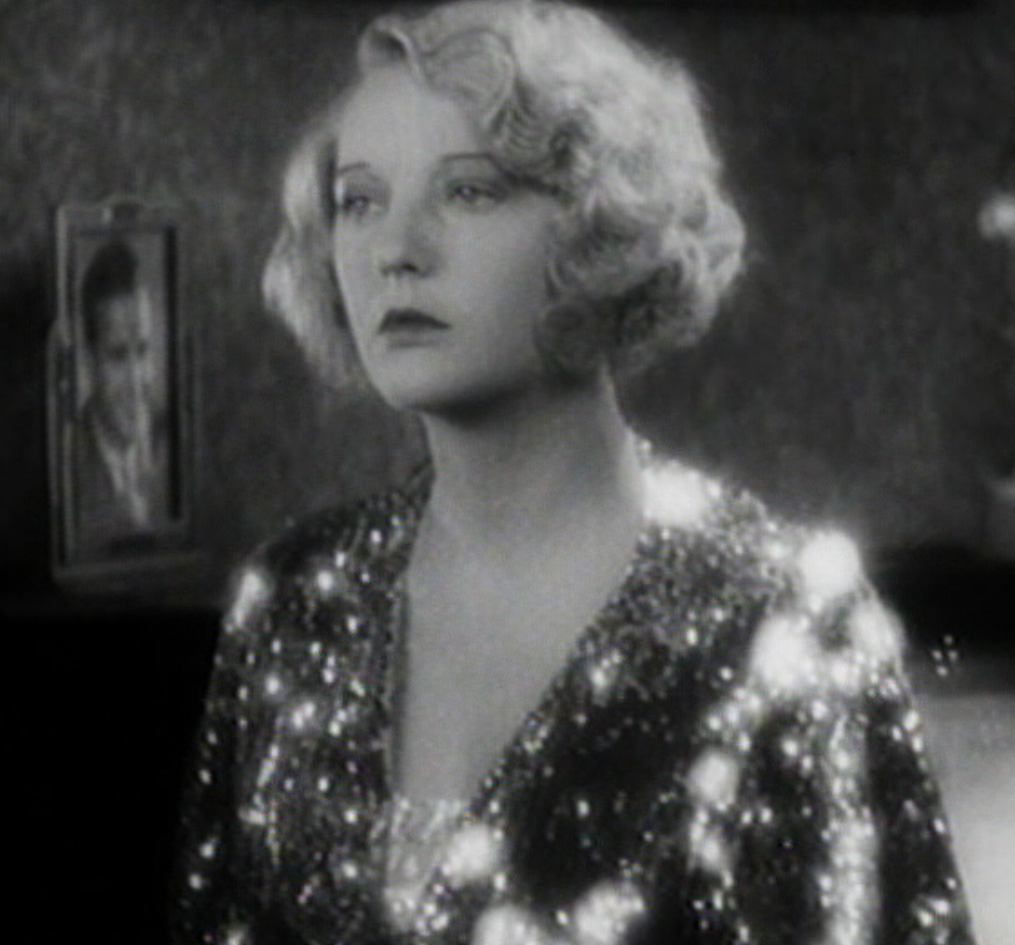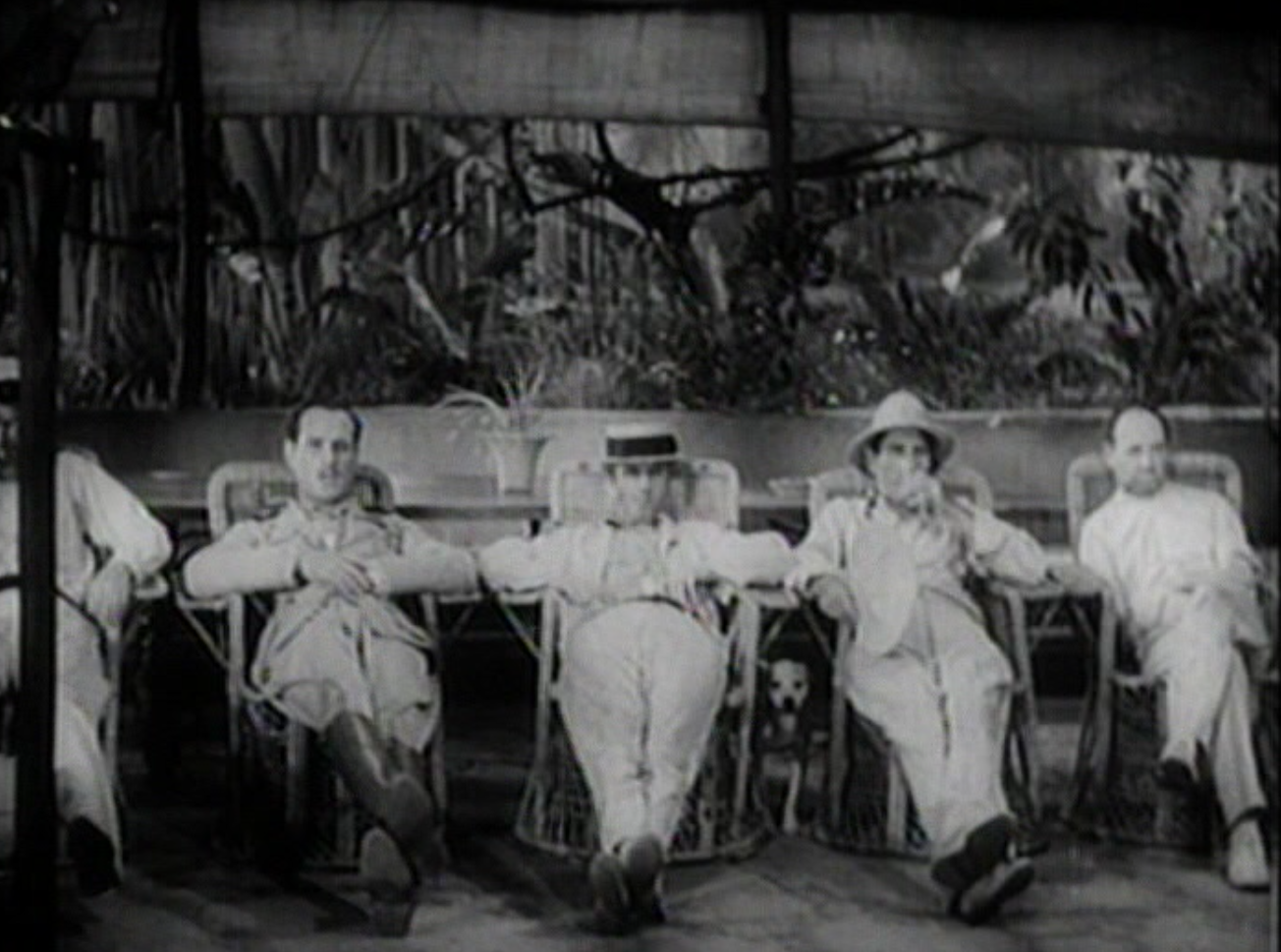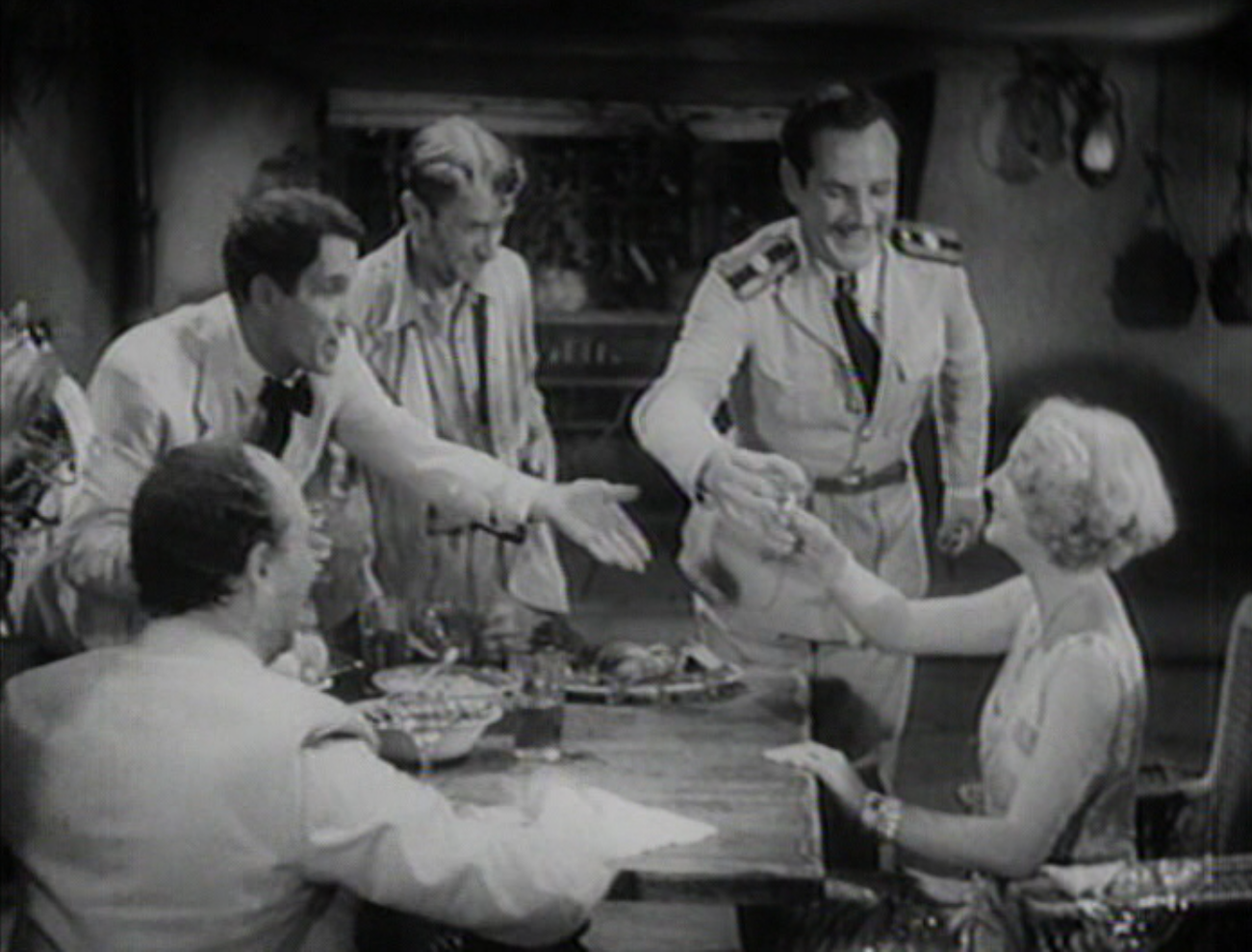William Wellman directed five movies in 1931, and?Safe in Hell?was the last of them. The movie was made under the same conditions as the other four, pretty much the same as several hundred others released that year by Hollywood studios. The mass production methods then in place made this kind of volume possible, and the studios ground out product relentlessly, on tight schedules and budgets, to feed the thousands of theaters across America (and across the globe, as well) and hopefully entice Depression-era audiences to open their emaciated wallets and park their worried selves for a couple hours.
Safe in Hell?was made exactly the same way as all those other movies. Of that crowded field some were hits, most were instantly forgotten, justly or not. A very few somehow managed to survive the decades, often?due to dumb luck, and become classics. And once in a long while we discover a movie that got little attention in its time but that now speaks to us in ways it didn?t register all those years ago.
On the surface?Safe in Hell?seems like a textbook Pre-Code, with all the trimmings: scantily clad sexy dames, colorful dialogue loaded with period slang, gangsters, murder, prostitution, partying, squalor?extra helpings of squalor that put it in a league with?Freaks, Kongo,?and?Island of Lost Souls.?It is a testament to Wellman?s skills that he could take the elements and arrange them into something compelling, something that still shocks and moves us 84 years later.?Safe in Hell?ranks among the most perverse Pre-Code films, and that is saying something.
But the movie has more soul than those other shockers. Maybe that?s its power: Pre-Code madness and underneath, compassion.
You might pause for a few seconds over the ending, which in the purity of its bleakness is matched by few films of the era (I Am a Fugitive from a Chain Gang?a prominent exception). Its atmosphere is, as another blogger pointed out, as thoroughly and relentlessly doom-drenched as Edgar G. Ulmer?s proto-noir?Detour, which was made more than a decade later.
In addition to the arsonists, mercenaries, crooked lawyers, and general sociopaths, there is the island executioner, who somehow manages to be even more disgusting than the criminals. He?s always chewing a filthy stogie, slanting upward. His walk is a sort of shuffle, and he wears his gun belt very low over his gaunt hips.
While?Safe in Hell?wasn?t a bomb, it certainly didn?t stand out in its time?not to audiences, critics, or even its director, who doesn?t mention it once in his memoir. But then again, since the movie disappeared into the vault after strict Code enforcement began two and a half years later, why should he?what?s the point of talking about a movie, one of 24 you made in the five years between 1929 and 1934, that just about nobody has ever seen or heard of, that appears to have slipped into the waters beyond memory or recovery?
I first saw?Safe in Hell?in 2013 at TCMFF, and it blew me away. I had never heard of it or its star, Dorothy Mackaill. I knew Wellman?s name and a few of his?films but was unprepared for the emotional wallop the movie delivers. Since then I?ve seen it a number of times, and even on repeat viewings it retains?that rare power.
So what is it that makes?Safe in Hell?so distinctive and intense? How did it come together the way it did, and what did Wellman contribute to its distinctiveness?
One of those things William Wellman said over and over was how much he hated working with women?waiting for them to put on their makeup, bothering about this and that, yadda yadda yadda. If he said it once he said it a hundred times. Wellman did everything he could to cement his image as a charter member of the He-Man Woman Hater?s Club, and most people bought it.
There?s just one thing: It wasn?t true. It?obviously?wasn?t true, and it?s easy to make that call just by watching his Pre-Code films starring Barbara Stanwyck, Loretta Young, Ruth Chatterton, and in the present case, Dorothy Mackaill in?Safe in Hell.
Wellman shoots these actresses with loving care and complete attention, and he gives Mackaill the full treatment in?Safe in Hell.?It?s not just the closeups, though those are plentiful and sympathetic, but even in the mid-shots his attention is always on her. And Mackaill?took this golden opportunity, the only one she got in the sound era, and ran with it, to give a career performance that is the equal of Stanwyck and other Pre-Code queens in its balls-out honesty, frankness, vulnerability and rage, sensuality, and tenderness.
Dorothy Mackaill was born in England?which will surprise you when you see her as Gilda Carlson, a New Orleans girl, in?Safe in Hell.?There?s not a trace of England in her accent. She moved to America in her teens to work on the stage in New York. She began appearing in films in 1920 and had her breakthrough role in 1924, after which she was a full-fledged star. She had appeared in 47 movies before?Safe in Hell,?and her performance as Gilda reflects all her?experience acting without speaking?her face is a pool on which emotions float and ripple fluently from one second to the next, and her eyes speak volumes. I don?t know if any of her silent films survive but I sure haven?t seen any (Hey silent film mavens, you know Mackaill?s silent work? Discuss). I?ve seen a few of her other sound films, and I would never have guessed that she had this performance in her. It?s a naturalistic performance, distinctly untheatrical. I believe her every minute.
She has a lovely, unusual face, as soft as a child?s, and her onscreen personality is rather muted. Perhaps that?s what kept her from making it in the sound era; some exec decided she lacked the intensity to compete with Davis, Crawford, Stanwyck, Hopkins, or the other live-wire actresses of the early sound period.
Or maybe she just didn?t have that inner steel, that by-any-means-necessary drive to succeed, which would put her in the company of other excellent actresses who were stars but not big stars (Astor, Blondell, Lupino, Farrell come to mind). Had I not seen?Safe in Hell?I would never have taken note of Dorothy Mackaill except as one of the hordes of starlets who came and went without the world noticing. But this performance, revealed to us 80 years after she gave it, proves that given the right part and director, she was capable of great things. Unfortunately, she never got another part this good, and she never again got to work with Wellman.
Wellman expert Frank Thompson spoke to me about the making of?Safe in Hell?and read excerpts from a letter his writing partner received from Miss Mackaill: ?He [Wellman] had the distinguished ability of making you see exactly how he wanted a scene played. He was most exacting, simpatico, and adorable.? She wished she had made more films with him??he was a treasure to work for, and he absolutely did things his way.?
When you see a movie that really works, it seems inevitable. You can?t imagine other stars in the roles, or a different look or soundtrack or another director. But the reality of making movies has always been more of a Rubik?s Cube, with pieces and variables shifting, sometimes right up through production.?Gone With the Wind,?that monument?to the glories of the studio system, was born painfully over a period of years, with Selznick barely holding together the chaos. That it would turn out as it did was far from certain.?Casablanca,?famously, the same.
Sometimes things just come together on the assembly line and something special happens.?Safe in Hell?is one of those movies?it?s not a masterpiece, but it?s way better than it ought to be, and Wellman and Mackaill are two big reasons why.
On its way to becoming the movie I love,?Safe in Hell?(then being referred to as ?the jinx picture?) was first set to be directed by Roy Del Ruth, then by Michael Curtiz, but he was moved to?The Woman from Monte Carlo?in mid-August. That gave Wellman about three weeks to work with the script before shooting commenced on September 8. Stanwyck and David Manners, who had been set to play Gilda?s true love Carl, were both dismissed. Boris Karloff, who had been discussed to play Bobo the policeman, was also released and the role was played by Noble Johnson.
Thompson says Wellman liked to work fast, but he did a lot of preparation before production began, scrawling notes in the margins of his shooting scripts. Mackaill was not the first or even second actress considered for Gilda; in addition to Stanwyck (who would seem the most promising alternate), there was Ziegfeld star Marilyn Miller, who would have made this a very different film indeed. But Mackaill it was, which was fine with Wellman. He liked her the way he liked other hard-working, reliable pros like Stanwyck, Lombard, and Chatterton, who showed up on time and ready to work.
The bulk of shooting was done at First National, with the church at the Warners Ranch. Aerial shots were done over Santa Cruz. Shooting wrapped on October 5, and the movie was released domestically on December 12, bringing in respectable grosses of $23,000 in its first three days at New York?s Strand Theatre.
So what did Wellman contribute to this little gem?
First, as noted, he directed Mackaill, but he also directed a supporting cast of grotesques that will make your skin crawl.
Thompson points out how important it is to remember, when watching studio movies, that a particularly interesting camera angle or edit isn?t via the director but whoever shot or edited the movie. Not only did directors not have final cut, they handed over their footage to the editor, who would whip it all into shape.
But?Safe in Hell?shows Wellman?s fingerprints in certain characteristic touches that are found in his other films. There are a pair of visual motifs throughout the movie, one signifying claustrophobia, entrapment, isolation?this is Gilda?s lot in a world of men who casually exploit her as property, from Piet, who ruins her and whose wife dogs her until she has no other employment possibilities but prostitution, to Bruno, who will do whatever he has to to get Gilda into his prison camp, including stealing her mail and framing her. There are bars and frames, mirrors that Gilda can barely stand to look into, rails on the stairs, the twisted metal of her bed frame bisecting her face as she talks to Carl, her face trapped in a windowpane.
The other motif is of freedom as embodied in ships and the sea, where Carl lives. The first shots of the movie are the docks of New Orleans, where cargo (Gilda is treated as freight) is unloaded. Carl brings Gilda a ship in a bottle, which he has made himself. The table centerpiece at a festive dinner at the hotel is a big ship. And out Gilda?s window is the sea, open and endless and empty?the sea that somewhere, Carl is sailing. But too far away to keep her safe. Even the sea becomes a disappointment. Not a vista of possibility but a reminder of how alone she is.
Thompson agrees that these motifs are too consistent and frequent in the movie not to mean something, and wonders if we might find them among the scrawled marginalia of Wellman?s shooting script.
Wellman also loved to shoot scenes where a significant portion of the scene is blocked. In?Safe in Hell,?he shoots an entire scene between Carl and Gilda, who is hiding in a crate, showing just her mouth between the crate?s slats. Thompson says that Wellman loved this particular effect so much he sometimes used it to no particular end, as in?Nothing Sacred,?where March and Lombard play a scene mostly hidden by a tree branch. But in this movie, it effectively shows Gilda?s disconnection.
I wonder if Wellman would approve of us looking at his women?s films? It would blow the cover on his man?s man pose. Thompson says, ?There were a lot of things he said that were not true.?he just loved to be provocative.?
Does an artist always know when they?re making a work whether it?s going to turn out bad, indifferent, good, or great? I think the answer is a definite ?Sometimes.? Sometimes you can feel it, when you?re in the zone, like Buster Keaton did when he was making?The General,?and it only takes 40 years for the rest of the world to catch up to you.
Mackaill?s?incredible work as Gilda didn?t impress Warner Bros execs enough to renew her?contract, and though she made a few more movies in the next couple of years, she retired from the screen in 1934 and never looked back. She?spent her last decades happily living in Hawaii, swimming every morning, and her last appearances were on the small screen as a guest star on her friend Jack Lord?s show,?Hawaii Five-0.?She is one of those inspiring stories of people who failed to become big stars and instead of eating their hearts out moved on and lived a full life off the screen.
In?Without Lying Down,?Carrie Beauchamp?s biography of screenwriter extraordinaire Frances Marion, there is a fascinating photo of one of Frances?s ?hen parties??evenings when she invited her women friends from the industry, without their boyfriends or husbands, to ?laugh until their sides ached.? There are 22 women in three rows, including stars and screenwriters like Colleen Moore, the three Talmadge sisters, Adela Rogers St. John, and Theda Bara. And there in the middle row, third from left, in a simple, elegant dark dress, is Dorothy Mackaill, who gave the performance she will be remembered for in?Safe in Hell.?She is looking straight into the camera, and her gaze, like Gilda?s, is direct and uncalculating.
But there she is, immortalized (as long as the movie survives, anyway), and William Wellman directed her in the one movie that gave her a role she could get her teeth into.
The third factor that may help us to see more in?Safe in Hell?than contemporary audiences did is changing sexual politics. Gilda?s inability?to protect herself from sexual exploitation is horrifying to us in a way it might not have been?in 1931. I?m not saying it wasn?t disturbing, but most people accepted that this is the way of the world. Now we?re not quite so accepting. Gilda lacks family, connections, money, education, skills?anything to stand on as a foundation to build a life. The only thing she has is her will to survive and Carl?s love, which isn?t enough to save her, but at least it gives her something to aspire to. In honoring her vow to Carl and God, Gilda rises above mere survival and self-loathing to value herself as nobody but Carl ever has.
That?Safe in Hell?should have escaped both destruction at the hands of the censors or just faulty storage, and the notice of not only its director but critics and film historians tells us something not just about the movie but about how history is written by the winners.
With many of Wellman?s?24 Pre-Codes out of circulation for five decades or more, they were often excluded from discussions of his?work, and Andrew Sarris and others appraised Wellman?s remarkable career without having a full picture. It would be like writing a study about Matisse but excluding everything he painted between 1914 and 1920. You couldn?t help but draw erroneous conclusions. Wellman was a man?s man who is mostly remembered for his war movies and westerns. The Pre-Codes show us something else, a director who had a gift for getting great performances out of women, for creating women characters who are as individualistic as his men.
Wellman, Mackaill, and a group of mostly unheralded studio workers put together this assemblage of bad breaks, star-crossed love and transcendent self-sacrifice that?s Gilda?s?only ticket out of hell. Hers is one of cinema?s epic refusals, a no so resolute it leaves us stunned.

?I love you?
?I know you do?and it?s made something different out of me than what I was. I?m good now, Carl, like I was when we was kids.?
More on Dorothy Mackaill:?A Blonde Less Tragic: Dorothy Mackaill??For more on?Safe in Hell😕Pre-Code.com: Safe in Hell?Safe in Hell (1931): Talkie Triumph for Tough Dorothy Mackaill?Safe in Hell (1931) from Warner Archive: When It Comes to Pre-Code, Seeing Is Believing This post was written for the?William Wellman Blogathon, generously hosted by Now Voyaging.
This post was written for the?William Wellman Blogathon, generously hosted by Now Voyaging.































Recent Comments